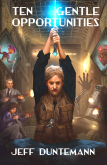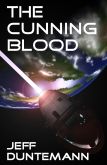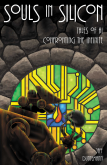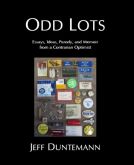- Here’s yet another brick in the structure I’ve been seeing in psychological research suggesting that beyond a certain (reasonable) point, the more confident you are, the less competent you are.
- The Japanese word I heard at MileHi Con but could not spell (and thus not find) is yaoi (boys’ love) which is evidently fiction targeted at women which portrays homoerotic/homoromantic relationships between good-looking young men. (Thanks to Erbo and Eric the Fruit Bat for clarifying this. I just had no clue.)
- And while we’re identifying obscure pop culture icons and references, I’ve seen this guy somewhere. Who/what is he?
- NASA’s new-technology space-based atomic clock has eight pins, and relies on high vacuum. George O. Smith would approve. (Thanks to Larry Nelson for the pointer.)
- Switch to a “mechanical keyboard”? I never stopped using them to begin with. Modern “mush” keyboards were created solely to be cheap and are mostly useless. (I love it when I’m right–and thanks to Pete Albrecht for the link.)
- How many people lived on Earth when you were born? For me, it was 2,556,061,949.
- The 99c MP3 of the Month Award here goes to Sam Spence for “Classic Battle,” which was evidently commissioned by the NFL as incidental music for football games. Dayum. Why doesn’t baseball get music like that?
- Music, heh. Ever hear a piece of music that immediately made you head for the exits? Maybe that’s the whole idea. (Thanks to Pete Albrecht for the pointer.)
- I’ve found a good home for my old Ampro CP/M system, and will be shipping it out shortly. Thanks for all the suggestions and reminiscences.
Odd Lots
Short items presented without much discussion, generally links to other Web items
Odd Lots
Odd Lots
- Jim Strickland and I will be attending MileHiCon in Denver this weekend. Anybody else listening gonna be there?
- I’m on a panel about robots, and here’s a megatrivia question for you: What was the first film depiction of a robot that was not a mechanical man; i.e., not things on two legs like Robbie, Gort, or Tobor the Great? The oldest one I can think of is the 1954 Gog. (Writeup.) This was a rare form factor back then (because humanoid robots were actors in robot suits) and the only other one from the Fifties I can recall is the 1957 Kronos.
- Pertinent to that question: There was a serious and reasonably big-budget Japanese SF movie in the early 60s (not a let’s-stomp-on-Tokyo thing) depicting a spaceship with a small robot named Omega that ran on tracks. The other vehicles on the starship were also given Greek letters as names. Can anybody remember what that film was? All I get on Google for “Omega the Robot” are Sonic the Hedgehog references.
- Having flown the X-37B into space twice, Boeing is now officially looking into doubling the size of the vehicle and making it a sort of people-only space shuttle. Alas, it would probably kill all hope for anything like the sexy li’l X-38–but I’ll take what we can get.
- Red tide algae glows blue after dark, if you shake it up enough. Pete Albrecht has seen this, and it’s real; nay, surreal.
- Boston Dynamics’ uncanny and brilliant Big Dog quadriped robot now has a big brother, AlphaDog. Watch both videos; the second is a demo of Big Dog doing stuff I wouldn’t have imagined a robot doing when I was in high school. BTW, that tube sticking out of Alpha Dog’s front panel isn’t artillery…yet.
- These guys will sell you a 144-core CPU–and then make you program it in FORTH. Not x86; each core is an 18-bit F18A processor executing the colorForth instruction set. FORTH ties my head in knots and yes, I’ve tried it–on the CDP1802 processor, no less. (Thanks to Frank Glover for the link.)
- Gotta love Google Books. I recently found a Popular Science article I had read in 1967 summarizing various rotary engines under discussion at that time. Nobody answered the obvious question: How do you machine a piston in the shape of a piece of kielbasa?
- A short 1963 book on rotary engines by Felix Wankel himself can be found here. (Multiple PDFs; not an easy read.) Thanks to Pete Albrecht for spotting it.
- From Henry Law comes a pointer to the most boggling piece of amateur rocketry I’ve ever seen. High power? Heh. One doesn’t get to 121,000 feet on vinegar and baking soda.
- You don’t have to speak or read German to appreciate this photo tour of Vienna’s sewers. Why do they get such cool sewers in Europe? (I’ve seen a few Stateside, and they just…stink.)
- Sure, and while you’re at it, grab his beach towel.
Odd Lots
- Maybe it’s some of the recent solar storms (the sunspots were not spectacularly high) but I heard both Guyana and the Cayman Islands on 17m the other day–the first time I’ve seen any significant life on that band in several years.
- I have yet to find an Android ebook reader app that will open and render an MS .lit file, of which I have several. No surprise: Having blown an early and promising start in ebook reader software, MS has recently announced that it is withdrawing the app. Reader is actually a nice piece of work, and the first ebook reader program I used regularly. DRMed .lit books are now just noise, and the rest of them will have to be translated by something like Calibre. DRM, especially when it’s abandoned, trains people to locate cracks and become pirates. Way to go, guys.
- SanDisk just announced a thumb drive about the size of its own USB connector cap. 4, 8, or 16GB. I’ve now broken two thumb drives by leaving them plugged into the rear edge of a laptop and then tipping the laptop back. If that’s a common problem, this is definitely the solution.
- What do you do with the Moon once you rope it down? (Watering it would be interesting, though Mars needs it more.)
- This guy thinks like I do. Just ask Carol. (Thanks to Michael Covington for the link.)
- I recently found a PDF describing the first computer I ever programmed for money. It was a…1 MHz…8080. It cost a boggling number of 1979 dollars, so Xerox ended up using most of the initial production run in-house. The 3200 cast a long shadow: I got so used to sitting in front of it that when I built a computer table later that year for my S100 CP/M system, I made it just high enough that the keyboard was precisely as far off the floor as the 3200’s, a height that I use in computer tables to this day.
- How long did it take you to figure out what this really was? (Thanks to Pete Albrecht for the link.)
- Russian President Medvedev has taken a liking to ReactOS, a long-running and mostly ignored attempt to create a driver-compatible, win32-friendly (via WINE) open source Windows clone. He’s suggesting that the Russian government fund it. Now if Medvedev can convince Putin, we could have quite a project on our hands.
- I’d never thought much about how you recycle a dead refrigerator. Now I know.
- Begorrah! Zombies are not a new problem. (Thanks to Frank Glover for the link.)
- And if that machine gun in your hollow leg won’t slow them down, send them into sugar crash.
Odd Lots
- Michael S. Hart, founder of Project Gutenberg and generally acknowledged as the inventor of the ebook, has left us. He was only 64.
- That supernova that popped up in M101 about ten days ago keeps getting brighter, and the 8″ scope is out in the garage, collimated and ready to roll. I have never seen a supernova (mostly because I’ve never hunted for the pikers that have appeared in my lifetime) but this is starting to look too good to miss. Brightness should peak in the next few days, and if the clouds would break here for an evening I think it would be reasonably easy to spot.
- White dwarf stars may be able to exceed the Chandrasekahr Limit by spinning rapidly–and as soon as their rotation slows down sufficiently, they collapse and go supernova. Such stars may be more common than we think, and offer a cool SF gimmick for galaxy-level warfare: Subtract a little rotational energy from a super-Chandrasekar white dwarf, and wham! Supernova-on-demand.
- An earlier article from the same site suggests that such spinning white dwarfs may be messing up a long-established luminosity heuristic for measuring the distance to far-off galaxies. If all similar white dwarf stars collapse and blow up at the same mass, their luminosity may be assumed to be about the same. If more massive stars can delay their destruction by absorbing angular momentum along with accreted mass, the metric fails.
- Getting uranium out of groundwater is a good thing–and when you’re done, you still have the uranium. (In my view, uranium is just as useful as clean water.) I energetically wonder if this process can be generalized. If so, then anyone could become The Man Who Ploughed the Sea.
- Damn, I’ll believe it when I see it, and if I actually see it I may not in fact believe it, but Heathkit is going back into the kit business!
- I’ve never seen this before and I doubt you have either: A razor-sharp composite photo of the Moon’s north pole.
- From whence the above: I could do with more science and less Science Guy, but if you don’t visit NASA Goddard’s Flickr photostream regularly, you are missing out bigtime. (Site virgins, prepare to lose an afternoon…)
- T’hell with home theater: If this thing is quiet, it could be a spectacular desktop for office apps. (Alas, I see no published spec on how loud it is or isn’t.)
- If more ties like this were available, I might wear ties more. (Especially the, er, cable tie.)
- Back in 1948, Bell Labs polled their staff to decide on a name for what may be their most potent invention. Also-rans include the solid triode, crystal triode, and (my favorite) the Tom-Swiftish iotatron. That’s just so much cooler than “transistor.”
- Hmmm. It seems that Yale scientists may be offering me the choice between being a bald head and a fat head. I may stay where I am.
- But, Miles, it’s full of… marshmallows !
Odd Lots
- Wired has a nice piece on the 1859 Carrington Event; basically, the strongest solar storm in the last 500 years, assuming ice core data is a reliable proxy for storm strength. Early landline telegraph operators actually disconnected their batteries and passed traffic solely on power induced in the lines by solar activity. Whew. Now that’s QRP!
- Alas, even with sunspot numbers hovering at 120, I’m not hearing much DX out here. I’m not even hearing the East Coast. So much for Cycle 24.
- There’s a difference between “loving reading” and “loving reading what the literary class loves to read.” We can teach the first. By teaching the second, we may teach a good many students to stop reading completely. (Thanks to Rev. Sharon Hart for the link.)
- Here be the history of Godwin’s Law.
- From the September 1922 issue of Popular Science comes a crystal radio in a corn-cob pipe, shown in one of the geekiest Roaring Twenties radio geek photos ever taken. I doubt this would work (well) but I suppose it had to be tried. (Thanks to David Stafford for the link.)
- This radio geek photo shows a set that would certainly work (schematic here) but I’m not sure he would have been let on an airliner even in 1936.
- By 1949, radio geek photos were in serious decline, but 15-year-old Hope Lange gave it a damned good try.
- By sheer coincidence, the cover of that very same issue of Popular Science cited above for the corn-cob radio shows a drawing of a “monocopter,” an unlikely but at least physically possible device modeled on maple tree seeds, which I mentioned in Odd Lots back on July 28. This should be easy to model; has anybody ever seen it done?
- Maybe I’ve been writing SF for so long that this article sounds a little obvious to me, but some of the points do need to be borne in mind by writers new to the field, particularly #3. (Thanks to Frank Glover for the link.)
- This was Big News in Germany. Those people need to get out more.
- I’m not sure what it is either, but if you’re going to cite its name as PIGORASS, you’d really better expand the acronym.
Odd Lots
- Does anybody here use true peer-to-peer chat? I don’t use chat much, and when I do it’s with a very small number of people, typically one-to-one. By peer-to-peer I mean via direct connect from one IP to another, without intermediation at the server level, as with things like Trillian, Skype, Jabber, etc. I know that WASTE does this, though I’ve never tried it. What else might work? I don’t want to mount a new server if I can avoid it.
- New research suggests that low-salt diets increase insulin resistance–and thus propel otherwise healthy people toward diabetes. (Via Fat Head.)
- More on Amazon’s rumored Android tablet. Print Replica (as I discussed in yesterday’s entry) has almost nothing to do with it.
- Note well: Sony’s new tablet is not really sideload-able, since the device cannot render content directly from an inserted SD card. You have to copy all material from the card to internal storage. Also, the weird cross-section makes it almost inescapably a landscape machine. No thanks.
- Interesting short piece on the other Delphi–as in, Oracle of.
- For those who asked: The 400W power supply I just bought for my Core 2 Quad is the Antec Neo Eco 400C. So far…love it!
- Having sold out all the TouchPads there were at fire-sale prices, HP now intends to…make some more. Something flaky here: Lose a little money on each sale, and make it up in volume? Doesn’t add up…unless it was a slick and risky attempt to build a demand base.
- Didn’t know this before: Setting a .jpg to quality setting 7 in Photoshop degrades the image’s quality. Stay at 6–or bump to 8.
- How about Han Solo Carbonite Slab ice cubes? Brilliant gimmick, though I wonder (given that the product is marked as “unavailable”) if they’re really out of stock or just didn’t close the deal with Lucasfilm.
Odd Lots
- Antique Electronic Supply in Tempe, Arizona, has created a new DBA for their tube audio amplifier business: Amplified Parts. The tube stuff still predominates but it’s hardly “antique” and has definitely gone upscale. They rate their power tubes like fine wine: “This Russian tube [6L6GC] has tight lows, straightforward body, and smooth highs. In overdrive, it offers a tight and frosted crunchy bite.”
- My Taos Toolbox 2011 colleague Alan Smale just won the Sidewise Award for Alternate History at the 2011 Worldcon in Reno. We workshopped an expansion of the winning story, “A Clash of Eagles” and it was terrific. I’m guessing this will make it perhaps a little easier to sell the novel-length work. Bravo, Alan!
- Even though HP announced yesterday that they were killing their cloud-centered TouchPad tablet, Carol and I saw an expensive commercial for the device on The Weather Channel this morning. Cloud? Did you guys say “cloud”? (No wonder they got the ad…)
- If you haven’t seen it yet, definitely take a look at Stellarium, a free planetarium program available for Windows, Mac, and Linux. It’s one of the best I’ve ever tried, more polished (if not as deep) as the venerable Cartes du Ciel, which is remarkable in part by being a Lazarus app.
- David Stafford sends word that an elaborate steampunk loft apartment has gone up for sale in Manhattan. The price? A “mere” $1,750,000.
- This is killer cool as binoculars go, but would they capture anything at night? (Somehow I doubt it.)
- Bill Higgins writes to tell us that Catholic University has placed a scan of the 1964 Treasure Chest comics series “Pettigrew for President” online, for free download. I blogged about this years ago, but the comic was not available for download then.
- Nick Kim does Cowboys and Heavy Metals. (Thanks to Pete Albrecht for the link.)
- Fellow carnivore Jim Tubman and I share an appreciation for The Periodic Table of Meat. Most of it, anyway. (No thanks on Meat 75. Oh, and 95.)
- Back from meat to metals again: Given that it’s the cornerstone material required to build the Hilbert Drive as used in many of my SF yarns, I was a little surprised that ytterbium is so cheap.
- Did you ever wonder about the physics of coffee rings? Wonder no more.
- From the Please-Give-Those-Guys-Something-To-Do Department: New taxpayer-funded NASA research tells us that unless we take prompt and serious action against global warming, aliens may invade and wipe us out. UPDATE: This turns out not to be entirely true: The chap who co-wrote the paper works for NASA but he did it on his own time and there was no public funding involved. The Guardian has corrected the piece.
Odd Lots
- The IBM PC turns 30 today. I had a dual-floppy 5150 and loved it. Hard to believe it came home almost thirty years ago.
- The number of retractions of dead-wrong and perhaps fraudulent scientific papers is surging, rising fifteen-fold in the last ten years. So what’s a citizen scientist to do? Probably not buy into just anything that might be in a peer-reviewed paper. (Maybe we need more peers. Or better ones.)
- Good example: There’s little or no evidence that salt causes hypertension, but that doesn’t stop certain scientists and many government functionaries from insisting that it does. (If salt did cause hypertension, I’d be…dead.)
- From the Words-I-Didn’t-Know-Until-I-Played-Scrabble-With-An-Expert Department: ort, which is a fancy but short word for leftover food scraps. As in, “Yesterday at 12:15 the junior-high lunchroom became an ort cloud…”
- The Perseid meteor shower peaks tonight just before dawn, but a nearly full moon will drown out many or most of the fainter traces. Hey, get up early and plop into a deck chair for a while. Assuming a clear sky, you’re almost guaranteed to see something. And there’s always next year. (Carol and I have been watching them as weather allows since 1969.)
- This is still extremely new, but it has promise: an AbiWord plug-in that exports epub files from within AbiWord. (I haven’t tested it yet.)
- Ditto for Open Office Writer. (Haven’t tested it either, but thanks to Sam’l Bassett for the link.)
- Are you the kind of reader who reads the ending in the bookstore before buying the book? (I used to be.) Apparently spoilers don’t spoil the fun of reading novels as much as most people assume.
- Who doesn’t like control panels? Here’s a wonderful album of panels from every sort of machine, from the Space Shuttle to the 1966 TV series Batmobile. Don’t miss Part 2. (Thanks to Ernie Marek for the links.)
- Wow. You used to be able to buy dynamite at the hardware store…at least if you were a farmer.
- Scott Adams thinks that boredom lies behind a lot of creativity. As we become less bored, we grow less creative. He may be right. But…how do we solve the Boredom Shortage? (Thanks to Pete Albrecht for the link.)
- I like butter. I like it a lot. But maybe not this much. (Thanks again to Pete Albrecht for the link.)
- Don’t just have your survivors give you a 21-gun salute. Be the 21-gun salute!
Odd Lots
- I guess I didn’t look hard enough last week: Pete Albrecht sent me a link to a site devoted to balloon molecules, using the same balloons that balloon artists twist into weiner dogs. The gallery contains lots of examples, from simple tetrahedra through Fullerenes and DNA, so don’t miss it!
- A neuroscientist calls BS on the Singularity. (Ok, the dialect of Singularitanism spoken in the vicinity of Ray Kurzweil.) What He Said.
- Using a laser sintering process (admittedly, on bigger parts than we’re used to seeing) some guys at the University of Southampton have created a 3-D printed UAV with a 6′ wingspan. 3-D printing sidesteps some of the difficulties of manufacturing certain shapes, including elliptical wings. (Thanks to Aaron Spriggs and half a dozen other people for the link.)
- Here’s a gallery of home-brew tube projects that’s one of the best I’ve seen. Take special note of the homebrew coil winder (design by Gingery) that made many of the designs possible. Here’s another link for the same writer.
- There is a NaNoWriMo alternate held in August. I think it really needs to be held in March (which I’ve considered the worst month of the year for decades) but nobody asked me.
- There was once a special phonograph record technology designed for use under car dashboards. It failed epically. I couldn’t stop vinyl records from skipping at home; one wonders what it would take to suppress skipping in a car on crappy Chicago streets. RCA created a different under-dash machine that played standard 45s, but by 1962 they’d all faded out with tailfins, waiting for the impending Age of 8-Track.
- Back in the day we sometimes Scotch-taped pennies on the tonearms of cheap record players to minimize skipping, and later wondered why the records started sounding crappy after awhile. (I think the term was “three-penny record.” I had more than my share.)
- Oh, dear. There may be an emerging film/fiction subsubgenre called “Fantastic Catholicism.”
- Here’s a nice short piece on some new research on airborne dust and its effect on atmospheric carbon levels. We’re finally getting a little hard data on the subject.
- “Wipe that grin off your face, Herr Luther.” (Thanks to Michael Covington for the link.)
Odd Lots
- A lot happened while I was down in Taos, and I’ll do my best to catch up a little here today. But as you’ve seen from my two entries about the workshop, it was tough to pay attention to anything there but the challenge at hand.
- More photos from the workshop: Christie Yant has established a single page linking to all four of her Flickr albums from Taos Toolbox 2011.
- Several people sent me invites to Google+, and I established an account several days ago. (I already had a Google account, so it was no big deal.) Google being insanely paranoid about how real your name is, look for me as…Jeff Duntemann.
- In the wake of Tuesday night’s epic natural gas leak here, I discovered that the ethyl mercaptan molecule resembles a balloon animal weiner dog with its hindquarters on upside down. Hey, I wonder if a balloon artist has ever done balloon hydrocarbons? (Google comes up empty.)
- Motorola is finally rolling out an Android upgrade that enables use of the Xoom’s SD slot. Guys, why was that so hard?
- Only a handful of people ever make it to 114 years old. And, weirdly, that’s when virtually all of the oldest of the oldest of the old actually die.
- Here’s a photo of the largest cannon ever built. No points for guessing who built it.
- And while you’re browsing Gizmodo’s Monster Machines category, don’t miss the largest Diesel engine in the world. Your flip-flops got paddled across the pond by something very like that.
- This SSD might well make that seven-year-old PC a little bouncier…but I still recommend maxing out RAM to 4 GB, cleaning the registry, and getting rid of crapware. I’m less convinced than some people that hard drive speeds are a serious bottleneck when your registry looks like an empty lot in a war zone.
- QBit, who on beach walks favors dead fish but will gladly settle for seaweed, has refused to answer the question: Why do dogs roll in stinky stuff?
- I doubt that this would ever work, irrespective of its cool halfway-to-dieselpunk looks. It does make me wonder what other cool stuff might have been drowned out in the racket coming from WWI. (Thanks to Gary Kato for the link.)
- And I know damned well that this wouldn’t work, but it goes all the way to full-bore, balls-out dieselpunk fantasy. (Thanks again to Gary Kato.)
- Perhaps you’ve seen the Dyson Fan on TV ads. Here’s how they work.
- The site is in German, and is well-known in Europe for high-end licorice. Pete Albrecht assures me that the name of the company really does translate as “Bearshit Pharmacy.” Wow.











